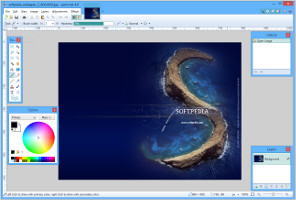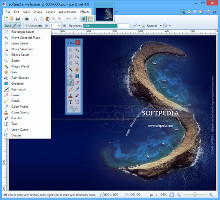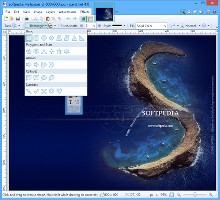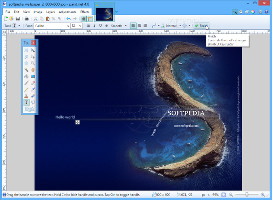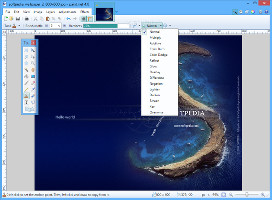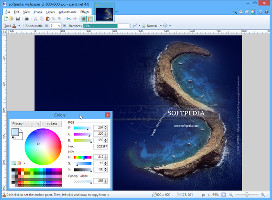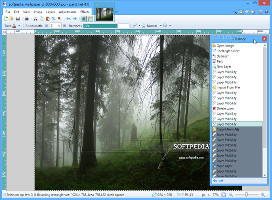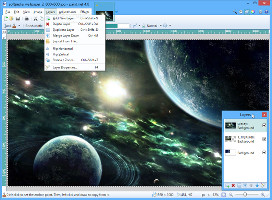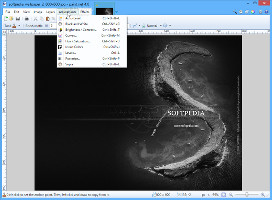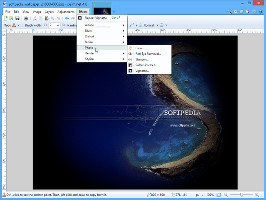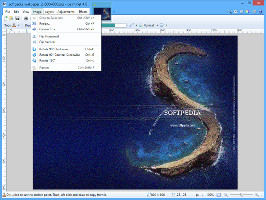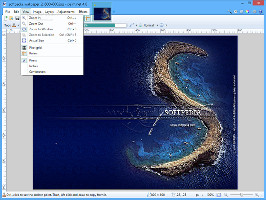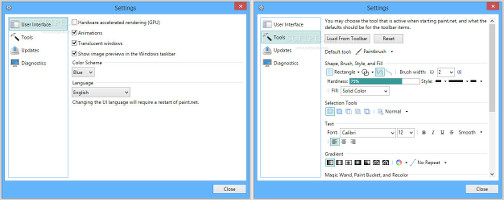PC users who consider that Photoshop is too difficult and expensive to work with may turn their heads toward paint.net, a lightweight and free image editor developed on the .NET Framework platform. Many consider it to be an essential application for Windows.
Originally made as a simple replacement for Microsoft Paint, this utility has grown into a full-fledged photo manipulator that could rival Photoshop or GIMP. The key difference lies in its approachable interface with intuitive options. Although it comes packed with a serious feature-set, it serves first-time users as well.
After many long years, the app's developers have finally rolled out a major update for paint.net. Version 4 brings new features and improvements to the table which concern effects, tools, selections, performance and general aspects.
NOTE: paint.net 4 was tested on Intel Core i5-3470 with CPU @3.20GHz and 12GB RAM, running on Windows 8.1 Pro.
Installation
The installer takes little time to finish. By default, paint.net makes file associations with JPEG, PNG, BMP and TGA images as the primary photo editor, and checks for software updates online automatically. Their options may be disabled by switching to custom installation mode. Since it is built on the .NET Framework platform, this component is needed before installing paint.net (.NET Framework 4.5 minimum, included in the package).
Interface, image list and file type support
paint.net's interface has been redesigned and looks flatter. It is just as easy to navigate as in the previous edition. Apart from the workspace, the app shows additional windows with drawing tools, history with actions, colors and layers. In version 4, all these four windows may be easily shown and hidden by clicking their corresponding buttons on the top-right corner of the main window. The settings area may be accessed from here, too.
Use the additional windows and open multiple imagesMultiple projects can be active simultaneously, thus enabling users to seamlessly switch through them. Unlike apps which support multiple tabs or windows, in paint.net the opened projects can be accessed from the right part of toolbar after examining their thumbnails (i.e. image list). A photo with unsaved changes is marked by a small orange asterisk. The image list has been moved up by one row in version 4, in order to make the workspace feel less cluttered. Apart from that, it can be re-arranged via drag-and-drop.paint.net's proprietary file type is PDN, so projects may be saved to this format and resumed at a later time. In addition to PDN, photos can be imported from and exported to BMP, GIF (non-animated only), JPEG, PNG (transparency supported), TIF, TGA and DDS (DirectDraw Surface-formatted). They can also be acquired from a scanner or camera. In version 4, EXIF rotation metadata is taken into account when opening images to correctly asses the composition.
Drawing tools
Users can pan the photo, make rectangular, free (Lasso) or ellipse selections, move selections or selected pixels and rotate them to any angle (mouse right-click), zoom in and out, apply the magic wand to make selections by color, resort to the paint bucket to fill color, and apply gradient (e.g. reflected linear, diamond, radial). It is possible to insert paint brushes and pencils, use a color picker and clone stamp, embed text, draw lines and curves, as well as apply various shapes (e.g. rectangles, polygons, symbols).
After users select a drawing tool, paint.net shows its available actions in the toolbar. For example, it is possible to make multiple selections, subtract, intersect and invert them, as well as to set a fixed size or ratio. The quality can be set to bilinear or nearest neighbor when moving selections, the flood mode can be set to contiguous or global when using the magic wand, while the selection clipping mode can be chosen between pixelated and anti-aliased selection quality, separately for each component from the entire toolbox.
Select tools and configure settingsThe solid color used for the paint bucket has a lot of fill types to choose from, such as large grid, diagonal cross, various percent sizes, small or large confetti, zig zag, sphere and solid diamond. In a similar manner, users may pick between a few gradient types to apply, along with the transparency or color mode.The color picker size is adjustable as well, ranging from a single pixel to 51x51 pixels. The level of tolerance determines the range of color used by tools, and it can be adjusted for the magic wand, paint bucket and recoloring. Likewise, the hardness level may be tweaked for the paint brush, eraser, clone stamp, and recoloring.
New features in drawing tools
paint.net 4 integrates a handy function that permits users to tinker with the settings made for most tools before actually applying them to the project. Clicking the "Finish" button is necessary to commit the changes.
Another new feature is represented by the blending mode made available for direct drawing when it comes to the paint bucket, gradient, paint brush, pencil, clone stamp, text, lines/curves and shapes. It can be modified from the toolbar (multiply or additive to darken or lighten pixels in the composition, color burn and dodge, and so on).
Tinker with settings before committing changesAs previously mentioned, it possible to rotate selections or selected pixels to any angle when moving them. In version 4, users may change the position of the rotation anchor; the selections can now be easily spotted thanks to the "dancing ants" animation. Compared to the previous edition where only rectangles, rounded rectangles, ellipses and freeform shapes were available, paint.net currently contains a total of 27 shapes (e.g. lightning bolt, check mark, callouts, arrows), and each one can be customized in terms of brush width, style, fill mode, and so on.The color picker's sampling mode may be picked between image and layer, while anti-aliasing is now supported for the paint bucket tool and all selections to improve the quality around the edges. The text tool features three rendering modes (smooth, modern sharp, classic sharp) and supports colored fonts in Windows 8.1.
Colors, History and Layers windows
From the Colors window users may choose the primary and secondary colors to apply to a tool, as well as navigate the color spectrum to locate something specific (alternatively, use the color picker in an image). Advanced users may expand this window to input RGB and HSV channel values as well as to adjust opacity. There are 32 preset colors available in the palette and each one can be replaced with a custom color. Palettes can be saved with their current configuration and reused at a later time. Settings can be restored to default.
Customize colors and retrace your actionsThe History window basically keeps track of all actions taken within the current project, enabling users to undo and redo actions one at a time, as well as to revert picture settings by jumping back to any step while automatically eliminating the following ones. Manage and blend multiple layers for your compositionAs any self-respectable advanced photo editor, paint.net supports multiple layers, which significantly simplify the user's job when blending compositions. From the Layers window it is possible to show, hide, duplicate, merge and re-arrange layers (drag-and-drop supported in version 4), as well as to edit properties regarding the layer name, visibility status, blending mode and opacity level. Additional options are available in the Layers menu, where layers can be added from external image files using the file browser (or drag-and-drop), flipped horizontally or vertically, rotated to any angle, panned, tiled, as well as zoomed in and out.Adjustments and effects
paint.net can be asked to automatically adjust the color levels, invert colors, or to convert the image to sepia or black and white based on its own parameters. The levels for brightness, contrast, hue, saturation, lightness and posterization (RGB channels) may be accurately tweaked, while results can be previewed in real time. Similarly, the color curves are adjustable based on the preferred transfer map (luminosity or RGB), along with the color levels.
Make image adjustments and apply effectsAs far as image effects are concerned, the application integrates several options classified by type: artistic (ink sketch, oil painting, pencil sketch), blurs (fragment, unfocus, Gaussian, motion, radial, surface and zoom blur), noise (add or reduce, median noise), photo (glow, red eye removal, sharpen, soften portrait, vignette), render (clouds, Julia or Mandelbrot fractals) and stylize (edge detect, emboss, outline, relief). The vignette effect is new to version 4. Just like the image adjustment options, the effects can be tweaked and previewed in real time.Other image/view options and program settings
The entire photo can be resized by percentage or absolute size with a preferred resampling method (best quality, bicubic, bilinear, nearest neighbor). Likewise, the canvas dimension may be changed, and its anchor can be easily set by indicating a position in the canvas. Images can be flipped horizontally or vertically, as well as rotated by 90 degrees clockwise or counter-clockwise, or 180 degrees. If the photo contains multiple layers, these can be combined into a single one via the "flatten" options. It is possible to show rulers and a pixel grid, as well as to select the measurement unit between pixels, inches and centimeters.
Set other image and view optionsConfiguring paint.net settings shouldn't be an issue, since there's nothing much to work with. Hardware accelerated rendering (GPU) can be enabled for the UI, while animations, translucent windows and image previews in the Windows taskbar may be deactivated to increase performance. The color scheme can be selected between blue and light blue, while the UI language can be changed (11 new languages are added to version 4).When it comes to the tools, it is possible to set the default tool when launching paint.net, along with the default tools and settings when selecting toolbar items. Automatic checkups for software updates can be enabled or disabled while taking into account or excluding beta versions.
Modify program settings to tweak performanceThe final tab in the settings panel shows system information (e.g. OS, .NET runtime, video card details) and allows users to open the crash log folders in Windows Explorer. The app's support for photo adjustments, effects and file types can be extended by installing plugins, since there are hundreds available online.Performance improvements
RAM usage is lower than in previous paint.net iterations. The utility is more responsive to commands when working with large-sized images, and the startup time is faster when loading many plugins (thanks to a new feature implemented in .NET Framework 4.5). As previously mentioned, hardware accelerated rendering (GPU) can be enabled, and it is supported via Direct2D. It scales performance based on the number of CPU cores.
The Good
CPU and RAM consumption was low in our tests. The photo editor worked smoothly on Windows 8.1 Pro.
It supports anti-aliasing and blending modes, transparency, layers, image adjustments and effects, and popular file types/ Support for adjustments, effects and file types can be extended with plugins. Actions can be easily undone thanks to the history window. Version 4 permits users to adjust properties before committing them to the picture via fine-grained history.
The Bad
There is no support for PSD and animated GIF file types (not without resorting to plugins, at least).
Images cannot be accurately cropped by adjusting the edges of the selection (similar to GIMP).
The Truth
NOTE: You can also read our review for Paint.NET 3.01.
 14 DAY TRIAL //
14 DAY TRIAL // 